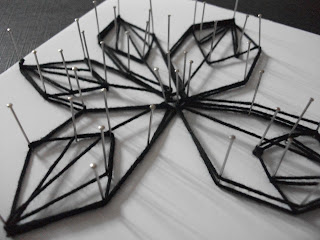A pattern found on the dream catcher I had previously drew
All of these
quick samples were about testing how to draw using the unique method of
dressmaking pins and black thread. I decided to use black thread instead of all
the other colours because in my drawings most of them were drew with black ink,
black thread also made the patterns stand out better on the white foam board
background. All of my chosen patterns were snippets taken from my summer
project, they differ in what they are but are all connected through structure and
refined form. I decided to use these materials as I’ve seen people create
amazing results using them, however, this was my first attempt at using these
materials so some of the patterns wasn’t 100% accurate and symmetrical which is
disappointing. I found using this method of materials difficult because they
was so intricate but this could have been due to the fact that my samples were
really small, on a larger scale I predict that the thread won’t be that hard to
maintain. I enjoyed experimenting with these new materials and would use them
more in my experimental work.
A tetrahedral prism that I had seen in an exhibition at the Tate Gallery in Liverpool
Symbols found on a hand-made leather chair that I had seen whilst on holiday in Lanzarote
A 5 petal origami flower drew using dressmaking pins and black thread




















